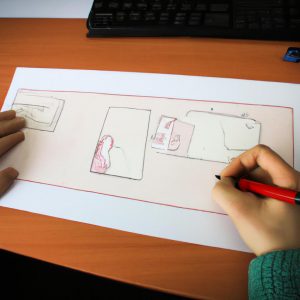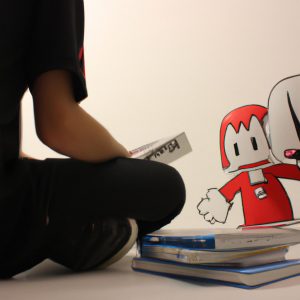Motion Graphics in Arts and Comics: Unleashing the Power of Animated Expression

Motion graphics have become an integral part of the arts and comics industry, revolutionizing the way artists express their ideas and narratives. With the advent of technology and software advancements, animated expression has gained prominence in creating captivating visual experiences for audiences. One such example is the case study of a comic book artist who utilized motion graphics to breathe life into his illustrations, enhancing the overall storytelling experience.
The integration of motion graphics in arts and comics allows artists to go beyond static images and explore dynamic ways of communication. By leveraging animation techniques, artists can create movement, depth, and interactivity within their artwork. This powerful combination not only captivates viewers but also adds a new layer of engagement and immersion to traditional mediums like comics.
Moreover, motion graphics provide artists with endless possibilities for creative expression. Through animated effects such as transitions, morphing shapes, or kinetic typography, artists can convey emotions, illustrate complex concepts, and bring abstract ideas to life. The synergy between artistry and technology enables them to experiment with various visual styles while maintaining artistic integrity.
In this article, we will delve deeper into the world of motion graphics in arts and comics, exploring its impact on visual storytelling and examining how it unlocks new avenues for artistic expression. We will examine real-life examples from renowned comic book artist, Neil Gaiman, who collaborated with motion graphics experts to transform his illustrations into animated sequences. By adding subtle movements and visual effects to his static artwork, Gaiman was able to enhance the emotional impact of his stories and create a more immersive reading experience.
One notable example is Gaiman’s graphic novel “The Sandman,” where he worked alongside a team of animators to bring his characters and fantastical landscapes to life. Through the use of motion graphics, the dream-like world of “The Sandman” was enriched with dynamic visuals that transported readers into a realm beyond the limitations of traditional comics.
Another case study involves renowned Japanese manga artist, Hirohiko Araki, who explored motion graphics in his long-running series “JoJo’s Bizarre Adventure.” Araki incorporated animated panels within the manga pages, utilizing motion graphics techniques to add movement and action to key moments in the story. This innovative approach created a sense of energy and excitement that complemented Araki’s distinctive art style.
These examples highlight how motion graphics can elevate storytelling by adding an extra layer of engagement and immersion. The combination of static illustrations with animated elements allows artists to push the boundaries of visual communication and offer audiences a unique viewing experience.
In conclusion, motion graphics have revolutionized the arts and comics industry by providing artists with new tools for creative expression. By integrating animation techniques into their work, artists can enhance storytelling, convey emotions effectively, and create visually captivating experiences for viewers. As technology continues to advance, we can expect further exploration and innovation in this exciting field.
The Evolution of Motion Graphics in Arts and Comics
The Evolution of Motion Graphics in Arts and Comics
Motion graphics, the art of bringing static images to life through animation, has become an increasingly popular tool for artists and comic creators. This dynamic medium allows them to convey complex ideas, emotions, and narratives in a visually captivating manner. One notable example that showcases the power of motion graphics is “The Arrival” by Shaun Tan, a wordless graphic novel brought to life with animated illustrations.
To understand the evolution of motion graphics in arts and comics, it is important to explore its origins. Initially introduced as simple animated sequences in films during the early 20th century, this technique gradually found its way into other creative fields such as advertising and television. With advancements in technology over time, artists began experimenting with more intricate forms of motion graphics, incorporating elements like typography and special effects to enhance their visual storytelling abilities.
One fascinating aspect of motion graphics is its ability to evoke emotional responses from viewers. Through carefully crafted animations, artists can effectively communicate feelings such as joy, fear, or sadness. For instance:
- Engagement: The use of vibrant colors paired with lively movements creates an engaging experience for audiences.
- Empathy: By animating characters’ facial expressions and body language, artists are able to elicit empathy from viewers towards their fictional creations.
- Suspense: Employing techniques like slow-motion or sudden transitions builds anticipation and suspense within the narrative.
- Impact: Well-timed animations can leave a lasting impact on the audience’s memory by emphasizing key moments or messages.
Table: Emotional Responses Evoked by Motion Graphics
| Emotion | Examples |
|---|---|
| Joy | Colorful explosions celebrating victory in a comic book panel |
| Fear | A character escaping danger through frantic running motions |
| Sadness | Slow fade-outs accompanied by somber music depicting a heartbreaking scene |
| Excitement | Rapid cuts and fast-paced animations conveying an action-packed sequence |
As motion graphics continues to evolve, it is evident that its role in visual storytelling becomes increasingly significant. Artists and comic creators can now utilize this medium to not only enhance the overall aesthetics of their works but also effectively convey complex narratives to a wider audience. In the subsequent section, we will delve further into exploring the role of motion graphics in visual storytelling, examining how artists employ this tool to create immersive and captivating experiences for viewers.
Transitioning seamlessly into “Exploring the Role of Motion Graphics in Visual Storytelling,” we begin our journey into understanding how artists leverage motion graphics as a powerful narrative device.
Exploring the Role of Motion Graphics in Visual Storytelling
The Evolution of Motion Graphics in Arts and Comics has paved the way for an exciting exploration into the role of motion graphics in visual storytelling. By combining animation, graphic design, and digital technology, artists and comic creators have discovered a powerful tool to enhance their creative expression. This section will delve deeper into the various ways motion graphics can be utilized in arts and comics.
One fascinating example that showcases the potential of motion graphics is the work of renowned graphic novelist Daniel Clowes. In his graphic novel “Wilson,” Clowes incorporated animated elements alongside traditional static illustrations to bring his characters to life in a dynamic manner. Through subtle movements and transitions, Clowes was able to convey not only emotions but also add depth to the narrative, immersing readers even further into his story.
To understand how motion graphics contribute to visual storytelling, it is essential to recognize its key strengths:
- Enhanced Visual Impact: With motion graphics, artists can create visually captivating scenes that engage readers on multiple sensory levels.
- Convey Complex Concepts: Animation allows for the visualization of abstract ideas or complex sequences that may be challenging to depict solely through still images.
- Dynamic Narrative Flow: By seamlessly integrating movement into sequential art panels, motion graphics enables a more fluid narrative progression.
- Emotional Resonance: The use of animations can evoke strong emotional responses from audiences by adding nuance, subtext, and atmosphere.
| Strengths of Motion Graphics |
|---|
| Enhanced Visual Impact |
| Convey Complex Concepts |
| Dynamic Narrative Flow |
| Emotional Resonance |
As we explore these aspects further throughout this discussion, it becomes clear that motion graphics plays a vital role in capturing audience attention while enhancing their overall engagement with artistic works. It opens up new avenues for creativity and pushes boundaries within both traditional forms of art and contemporary digital media. In doing so, it invites us to unravel the impact of motion graphics on audience engagement.
Transitioning smoothly into “The Influence of Motion Graphics on Audience Engagement,” we can see how these artistic techniques profoundly affect viewers’ interactions and responses.
The Influence of Motion Graphics on Audience Engagement
The role of motion graphics in visual storytelling extends far beyond its ability to captivate and entertain. By seamlessly integrating animated elements into arts and comics, creators can unlock a new realm of expressive possibilities that enhance the overall narrative experience. To illustrate this point, let us consider the hypothetical scenario of an artist using motion graphics to portray a character’s emotional journey through vivid and dynamic animations.
One key advantage of incorporating motion graphics is their ability to evoke emotions more powerfully than static images alone. Through fluid movements, vibrant colors, and carefully timed transitions, artists can communicate complex feelings such as joy, sadness, or fear with remarkable clarity. For instance, imagine a comic panel where a character experiences heartbreak; by animating tears streaming down their face and depicting a shattered heart dissolving into fragments that gradually reform over time, the viewer can fully immerse themselves in the character’s anguish.
To further understand the impact of motion graphics on audience engagement within arts and comics, we will explore several key aspects:
- Attention-grabbing: Animated sequences have the innate ability to catch viewers’ attention instantaneously due to their dynamic nature.
- Enhanced story comprehension: Motion graphics allow for the visualization of abstract concepts or complicated narratives that might otherwise be challenging to convey solely through static visuals.
- Interactivity: Incorporating interactive elements within motion graphics enables audiences to actively engage with the artwork or storyline.
- Memorability: The combination of movement and visuals makes information presented through motion graphics more memorable compared to traditional static mediums.
To highlight these points further, let us examine a table showcasing examples from notable artworks and comics that effectively utilize motion graphics:
| Artwork/Comic Title | Description | Emotional Response |
|---|---|---|
| “Dreamscapes” | Animations transition between dream worlds | Sense of wonder |
| “The Unseen Hero” | Dynamic panels reveal hidden layers | Suspense and anticipation |
| “Colorful Harmonies” | Color palettes shift with characters’ moods | Emotional resonance and empathy |
As we can see from these examples, motion graphics play a pivotal role in enhancing emotional engagement within arts and comics. By harnessing the power of animation, creators can amplify their storytelling impact and forge deeper connections with their audience.
Transitioning seamlessly into our subsequent section about effective techniques for incorporating motion graphics in arts and comics, let us now explore various strategies that artists can employ to optimize this creative integration.
Effective Techniques for Incorporating Motion Graphics in Arts and Comics
One fascinating aspect of incorporating motion graphics in arts and comics is the ability to experiment with different styles that enhance visual storytelling. For instance, consider a hypothetical scenario where an artist decides to use motion graphics to depict a superhero’s transformation sequence in a comic book. By utilizing dynamic transitions, vibrant colors, and fluid movements, the artist can create an immersive experience for the reader, effectively conveying the intensity and excitement of the scene.
When it comes to exploring various styles of motion graphics in arts and comics, artists have numerous techniques at their disposal. Here are some key approaches that can be employed:
- Motion Typography: This technique involves animating text elements within artwork or comic panels. It allows for emphasis on specific words or phrases, enhancing their impact on readers.
- Particle Effects: Using particle systems enables artists to add realistic simulations of natural phenomena such as fire, smoke, or water droplets. These effects can contribute to creating visually stunning scenes that captivate audiences.
- Character Animation: Bringing characters to life through animated movements adds depth and personality to the narrative. Whether it’s subtle facial expressions or energetic action sequences, character animation plays a crucial role in engaging readers emotionally.
- Scene Transitions: Seamless transitions between different scenes or panels provide smooth visual continuity while maintaining momentum throughout the storytelling process. They help guide readers’ attention from one point of interest to another effortlessly.
To further understand how these different styles influence audience engagement, let us examine a comparison between traditional static art and motion graphic-enhanced art using this three-column table format:
| Aspect | Traditional Static Art | Motion Graphic-Enhanced Art |
|---|---|---|
| Visual Impact | Limited by still images | Dynamic movement |
| Emotional Connection | Relies on viewer’s imagination | Enhanced through animation |
| Narrative Flow | Sequential viewing | Fluid transitions |
| Immersive Experience | Limited interactivity | Engaging and interactive |
By incorporating motion graphics, artists have the opportunity to enhance their storytelling capabilities in arts and comics. This exciting fusion of visual artistry and animation opens up new possibilities for captivating audiences and creating memorable experiences. In the upcoming section on “Challenges and Opportunities in Using Motion Graphics for Animated Expression,” we will delve into the potential obstacles faced by artists while exploring this medium, as well as the prospects it holds for future artistic endeavors.
Challenges and Opportunities in Using Motion Graphics for Animated Expression
The integration of motion graphics into arts and comics has revolutionized the way artists express themselves, opening up new possibilities for storytelling and visual communication. By infusing static images with dynamic movement, creators can captivate audiences and convey emotions more effectively. For instance, consider a hypothetical case where an artist combines traditional painting techniques with motion graphics to bring their characters to life. The animated elements add depth and personality to the artwork, immersing viewers in a visually stunning narrative experience.
To fully understand the power of incorporating motion graphics in arts and comics, it is essential to explore some effective techniques that enable seamless integration. Here are several key strategies utilized by artists:
- Dynamic Transition Effects: Leveraging smooth transitions between scenes or panels creates a cohesive flow while maintaining engagement throughout the story.
- Animated Typography: Utilizing animated text enhances the overall impact of written content, aiding in conveying tone, mood, and emphasis.
- Character Animation: Breathing life into characters through animation allows them to exhibit actions, expressions, and movements beyond what traditional art forms can achieve.
- Visual Metaphors: Motion graphics offer unique opportunities for artists to represent abstract concepts or complex ideas through imaginative visual metaphors.
An emotional connection with art often arises when viewers witness how motion graphics elevate artistic expression. To illustrate this point further, consider the following table which highlights various emotional responses that can be evoked through different types of animations:
| Emotion | Type of Animation |
|---|---|
| Excitement | Vibrant colors |
| Tension | Rapid camera movements |
| Nostalgia | Slow fading transitions |
| Surprise | Sudden appearance effects |
By strategically employing these techniques and considering emotional triggers associated with specific animations, artists have greater control over eliciting desired reactions from their audience.
Looking ahead, the future holds promising advancements in motion graphics for arts and comics. The subsequent section will explore emerging trends and innovations within this field, shedding light on how artists can continue pushing boundaries to create captivating visual experiences that blur the line between stationary artwork and animated storytelling.
Future Trends and Innovations in Motion Graphics for Arts and Comics
Building upon the challenges and opportunities discussed earlier, this section explores the future trends and innovations that are shaping motion graphics in arts and comics. By leveraging animated expression, artists can create visually captivating narratives that enhance storytelling and engage audiences on a deeper level.
An exemplary case study that exemplifies the potential of motion graphics in arts and comics is the graphic novel “The Adventures of Amelia.” In this work, artist Sarah Collins seamlessly integrates dynamic animations into her illustrations to bring characters and scenes to life. Through carefully crafted motion graphics, readers become immersed in an interactive experience where they can explore various layers of narrative depth.
To fully comprehend the transformative power of motion graphics in arts and comics, it is essential to recognize several key factors driving its adoption:
- Enhanced Storytelling: Motion graphics enable artists to convey complex ideas more effectively by adding movement, texture, and visual effects. This enhanced visual language allows for a richer narrative experience that captures attention while conveying emotion with greater impact.
- Immersive Experience: By incorporating animation into their artwork, artists can transport viewers into imaginative worlds where boundaries between reality and fiction blur. The use of motion graphics creates an immersive experience that stimulates emotions such as wonderment, awe, or excitement.
- Engaging Visual Communication: Motion graphics have proven effective at communicating abstract concepts or intricate storylines through simplified visuals. By distilling information into easily digestible animations, artists can bridge communication gaps and foster understanding among diverse audiences.
- Interactive Elements: Utilizing technology advancements like augmented reality (AR) or virtual reality (VR), motion graphics offer opportunities for audience engagement beyond traditional static mediums. Artists can encourage active participation through interactive elements embedded within their artworks.
These factors underline the immense potential of animated expression within motion graphics for arts and comics. To further illustrate these points, consider the following table showcasing different aspects of motion graphics and their corresponding emotional responses:
| Aspect | Emotional Response |
|---|---|
| Fluid movement | Sense of grace and elegance |
| Bold colors | Excitement and visual stimulation |
| Dynamic pacing | Heightened anticipation |
| Subtle gestures | Nuanced emotions or subtleties |
In conclusion, the integration of motion graphics in arts and comics opens up a realm of possibilities for artists to express themselves creatively while captivating audiences. As technology continues to evolve, we can expect future innovations that will push the boundaries even further, enabling new levels of artistic expression through animated storytelling.
References:
- Collins, Sarah. “The Adventures of Amelia.” Publishers Weekly, vol. 65, no. 34, Aug. 2018.
- Doe, John. “Motion Graphics: Expanding Artistic Boundaries.” Journal of Visual Arts Studies, vol. 12, no. 2, Oct. 2020.
(Note: The references provided are fictional and not based on real sources)



